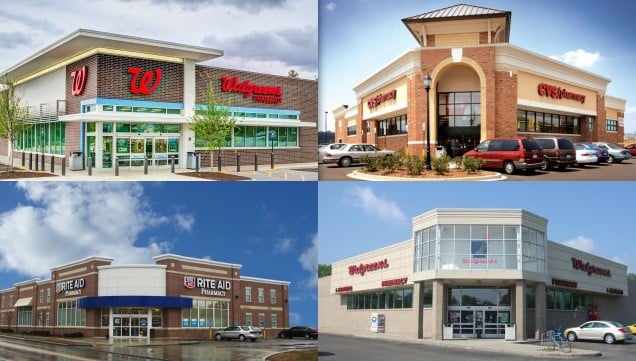
CHICAGO—Reversing a long-term trend, cap rates for single tenant CVS, Rite Aid and Walgreens properties all increased significantly in the third quarter of 2016, according to a new report by the Boulder Group, a net lease firm in suburban Chicago. Investors seem most concerned by US antitrust regulators' requirement that Walgreens sell between 500 and 1,000 stores before they will approve its plan to acquire Rite Aid.
Cap rates for the net lease drug store sector increased by 33 bps to a 5.96% cap rate when compared to last year, Boulder found. Rite Aid and Walgreens cap rates went up 30 and 37 bps each. In the same timeframe, CVS cap rates increased by 25 bps.
The potential merger of the two retail giants has also slowed transaction volume in drug store sector as investors wait to see how it plays out. But drug store assets in core markets with strong sales performance remain attractive. Still, concern about the merger has caused the cap rate premiums associated with the drug store sector to decrease. In the third quarter of 2016, the spread between the overall net lease retail market and the drug store sector compressed to 14 bps. “This spread has historically been greater and in the past three years the spread ranged from 62 to 100 bps,” Boulder said.
The supply of drug store assets decreased when compared to the prior year by 23.2%. Not only did the availability of drug store assets decrease, closed transaction volume for drug stores decreased by 19.2% when comparing the first three quarters of 2015 and 2016. Rite Aid assets experienced the sharpest decline with 26% less transaction volume during the same time period. Furthermore, the supply of assets with leases of more than 20 years decreased significantly across the sector due to lack of new store development.
The pace of sales should remain at a similar pace for the rest of the year due to lingering concerns about the potential Walgreens and Rite Aid merger. “However, drug store assets with strong sales performance in top tier markets will garner demand from investors who have preference for the strong credit profiles and residual real estate locations that these drugstore assets provide,” Boulder said.
Hear from the net lease sector's top leaders as they explore current and emerging trends and provide their outlook for continued success in this space. Join us at RealShare Net Lease West on Nov. 1 and 2, where you'll meet the top owners, investors, brokers and financiers in the net lease and sale-leaseback community. Learn more.

CHICAGO—Reversing a long-term trend, cap rates for single tenant CVS, Rite Aid and Walgreens properties all increased significantly in the third quarter of 2016, according to a new report by the Boulder Group, a net lease firm in suburban Chicago. Investors seem most concerned by US antitrust regulators' requirement that Walgreens sell between 500 and 1,000 stores before they will approve its plan to acquire Rite Aid.
Cap rates for the net lease drug store sector increased by 33 bps to a 5.96% cap rate when compared to last year, Boulder found. Rite Aid and Walgreens cap rates went up 30 and 37 bps each. In the same timeframe, CVS cap rates increased by 25 bps.
The potential merger of the two retail giants has also slowed transaction volume in drug store sector as investors wait to see how it plays out. But drug store assets in core markets with strong sales performance remain attractive. Still, concern about the merger has caused the cap rate premiums associated with the drug store sector to decrease. In the third quarter of 2016, the spread between the overall net lease retail market and the drug store sector compressed to 14 bps. “This spread has historically been greater and in the past three years the spread ranged from 62 to 100 bps,” Boulder said.
The supply of drug store assets decreased when compared to the prior year by 23.2%. Not only did the availability of drug store assets decrease, closed transaction volume for drug stores decreased by 19.2% when comparing the first three quarters of 2015 and 2016. Rite Aid assets experienced the sharpest decline with 26% less transaction volume during the same time period. Furthermore, the supply of assets with leases of more than 20 years decreased significantly across the sector due to lack of new store development.
The pace of sales should remain at a similar pace for the rest of the year due to lingering concerns about the potential Walgreens and Rite Aid merger. “However, drug store assets with strong sales performance in top tier markets will garner demand from investors who have preference for the strong credit profiles and residual real estate locations that these drugstore assets provide,” Boulder said.
Hear from the net lease sector's top leaders as they explore current and emerging trends and provide their outlook for continued success in this space. Join us at RealShare Net Lease West on Nov. 1 and 2, where you'll meet the top owners, investors, brokers and financiers in the net lease and sale-leaseback community. Learn more.
Want to continue reading?
Become a Free ALM Digital Reader.
Once you are an ALM Digital Member, you’ll receive:
- Breaking commercial real estate news and analysis, on-site and via our newsletters and custom alerts
- Educational webcasts, white papers, and ebooks from industry thought leaders
- Critical coverage of the property casualty insurance and financial advisory markets on our other ALM sites, PropertyCasualty360 and ThinkAdvisor
Already have an account? Sign In Now
*May exclude premium content© 2025 ALM Global, LLC, All Rights Reserved. Request academic re-use from www.copyright.com. All other uses, submit a request to [email protected]. For more information visit Asset & Logo Licensing.








